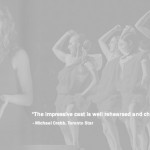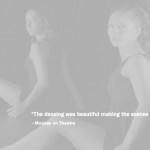The inspiration for this log entry came to me about two weeks ago when one of the students of Limitless Productions’ Dance in my ‘hood workshops asked me, “how much do you weigh?” and then proceeded to backpedal by saying, “what’s the right weight for a dancer?” While I had not thought much about it back then, later on that day the last ten years of my life rushed across the screen of my memory.
I had been an anorexic in denial for about five years. Having been a chubby child, I had jumped on the trial membership at a local gym in my late teens and worked hard to lose the excess weight I had on. Following that, I had unintentionally lost a lot more weight due to a bout of illness brought on by food poisoning. But instead of nursing myself back to health I had happily welcomed this weight loss and proceeded to maintain this unhealthy weight. Hardly willing to accept that my compulsion to work out and continue to eat less was a prime symptom for anorexia, I willingly welcomed the low blood pressure and lost opportunities as long as I could look at myself in the mirror and not feel like I was the same overweight child from long ago. Standing at 5 feet and 7 inches and weighing about 130 pounds I felt like I was on cloud nine. My slender frame gave me a new found confidence that I was able to dance for longer periods of time and recover faster during breaks and probably looked phenomenal as a thin dancer. The wake up calls that would shake me to the core but would not stick with me happened when an aggressive movement on my part or a slip up would cause my right arm to partially dislocate from the shoulder. While it felt like eternity for me to realign myself and call my arm to pop back in I would later realize that only less than a minute would have lapsed for that episode to last. Those few seconds of partial dislocation resulted in a pain that would last me a couple of weeks. Nothing, not even public occurence of these dislocations, could convince me that I was underweight, anorexic, suffering from low blood pressure, and a spine that felt like it would pierce through my skin and be on full public display any day now. To boot, I was in the most adamant denial of every single one of these symptoms.
About five years into this eating disorder I had begun to take formal dance training. While I felt elated during a dance sequence my choreographers would often comment on how I lacked strength while dancing. Initially, I had assumed this meant speed and attitude. But no amount of expressions would make up for the “force to reckon with” to show up in my performance. The worst was when I’d dance a beat and a half ahead of everyone else and my hip hop choreographer at that the time would single me out and punish me with twenty push ups. Following the hip hop rehearsals I’d go home and practice harder and longer. Halfway through the week I’d often look at the rehearsal videos and I’d always hate looking at my posture, my insignificant stage presence, my limp arm movements, my messy balance and generally how tired I looked and how much fresher and active everyone else seemed to look.
Then one day, on my way to the rehearsal in the bus I bumped into my choreographer. We began talking and I asked him for some feedback. He mentioned strength. I was ready for him this time. I asked what he meant by it and how I could get more strength. He finally confided in me that strength came not just from training hard but actually rewarding the body for all that hard work. The only way I could reward my body was to nourish it so that it had enough fuel at its disposal to perform better. Back then, my choreographer had suggested that I actually might want to start overeating on the days that I had rehearsals. He asked me to stay away from pop and red meat but allow myself generous portions of white meat, seafood and fruit juices. I don’t think I had fully comprehended what he meant but I tried it anyway. I felt very guilty and almost fearful of the consequences of feeding my body as much as it was crying out for all these years. The first day that I had overfed myself, I actually slept quite deeply and woke up unusually energized in the morning. As the week progressed I felt the spring in my step. As the month progressed I felt my endurance rising. The following month my choreographer asked to speak outside the rehearsal studio. There he gave me my first and most memorable feedback in a long time. He actually told me that he was impressed by how I was “attacking” every move and that my strength had been increasing. My choreographer encouraged me to continue with whatever I was doing and work harder. He rounded up the chat by saying that I was beginning to look better than before.
My moment of full realization and intense happiness came when my choreographer from Limitless Productions had called me back after a year long hiatus to do a Contemporary dance routine which involved lifting my partner and holding her and my own weight. While the result actually satisfied us, it was the ease and my ability to be grounded and remain strong for my partner that surprised me to no end. To this day I remember hopping around the rehearsal space out of joy and clapping away at myself. The understanding had finally descended upon me. I had now realized that being thin doesn’t mean you look better, feel better or even are better. Unless I fully satisfy the needs of my body through nourishment and conditioning, I cannot expect it to perform the way I would like it to. We put our bodies through so much and yet it doesn’t take more than 15 minutes to satisfy its needs. It’s only a matter of giving it the raw materials it needs. This wonderful system does the necessary to try to convert fuel into energy and overall sense of well-being. It isn’t so much the weight that is of significance for a dancer, as much as the strength and control over ones body. In the past two years I have seen dance shows on TV that have featured dancers of all shapes and sizes. What puts a certain dancer a cut above the rest is not how much they weigh but actually how physically and technically strong they are as perfomers. A healthy diet in optimum quantities, sensible exercise routine and sufficient rest are extremely important to be able to excel is any undertaking in our daily lives. Being aware of our physicality and proudly accepting our body for what it is with all its unique features and quirks alike not only will be able to become better performers but also mature as loving, productive and well-rounded human beings.
So to answer the question, there is no ideal weight for being a dancer. It is your commitment to the dance piece and your love for yourself despite your “physical faults” that ultimately counts. If thin were ever the be all, end all, it wouldn’t be Hillary Clinton but the Olsen twins who would be the First Ladies of the United States and Celine Dion would be the Governor General of Canada.










